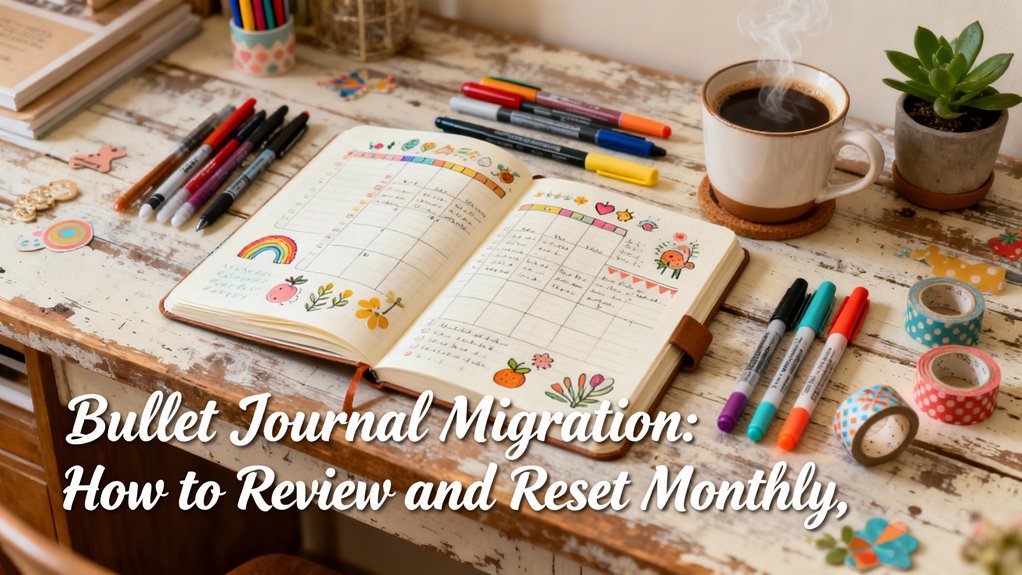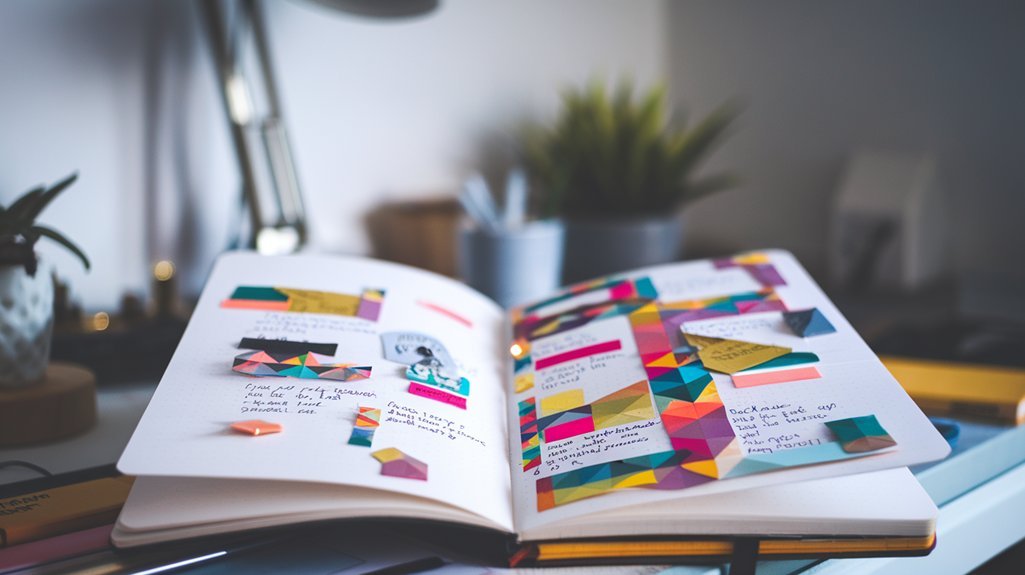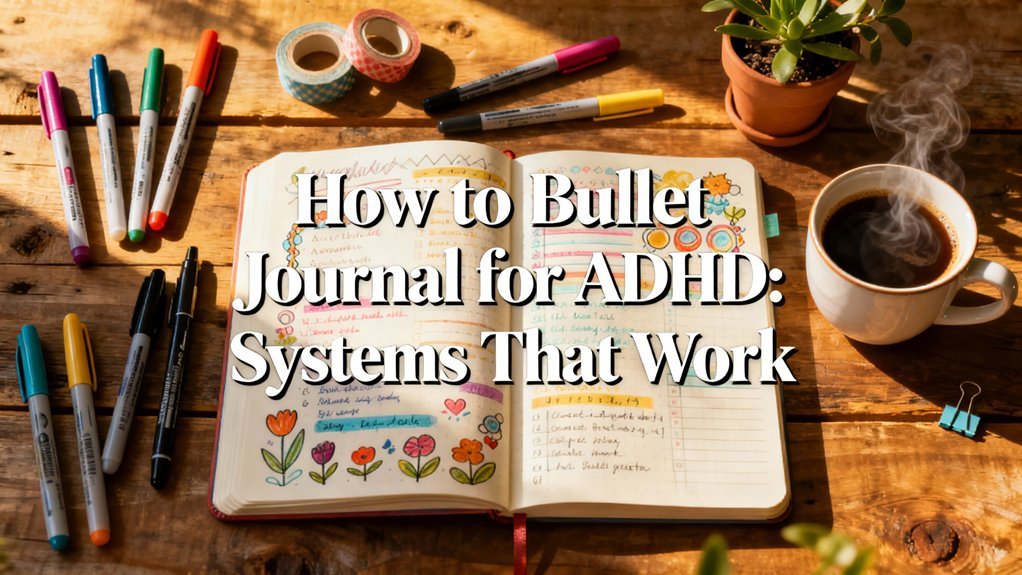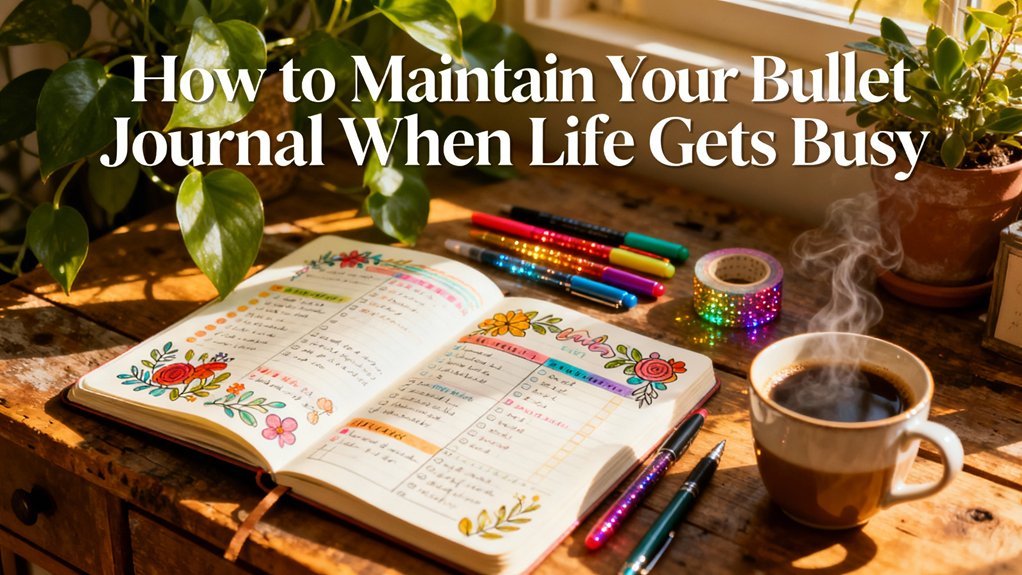You can fix bullet journal mistakes using white correction tape for clean coverage, decorative washi tape to mask errors, or white gel pens for precise touch-ups. Alter misspellings into creative doodles and turn wonky lines into intentional design features. For ink smudges, blot immediately with scrap paper and layer gesso over stubborn marks. Test new pens on your journal's last page first. Remember, imperfections add personality to your spreads—they're not failures but opportunities for creative problem-solving. The techniques below will show you exactly how to salvage any mistake.
Key Takeaways
- Use white correction tape or gel pens to cleanly cover errors and write over them without tearing pages.
- Apply decorative washi tape to mask mistakes while adding visual interest to your spreads.
- Transform misspellings or ink blots into creative doodles, illustrations, or intentional design elements.
- Blot ink smudges immediately with blotting paper, then layer gesso or white gel pen over stubborn marks.
- Embrace imperfections as authentic character rather than failures, maintaining journal functionality over perfectionism.
Quick Cover-Up Solutions for Minor Mistakes
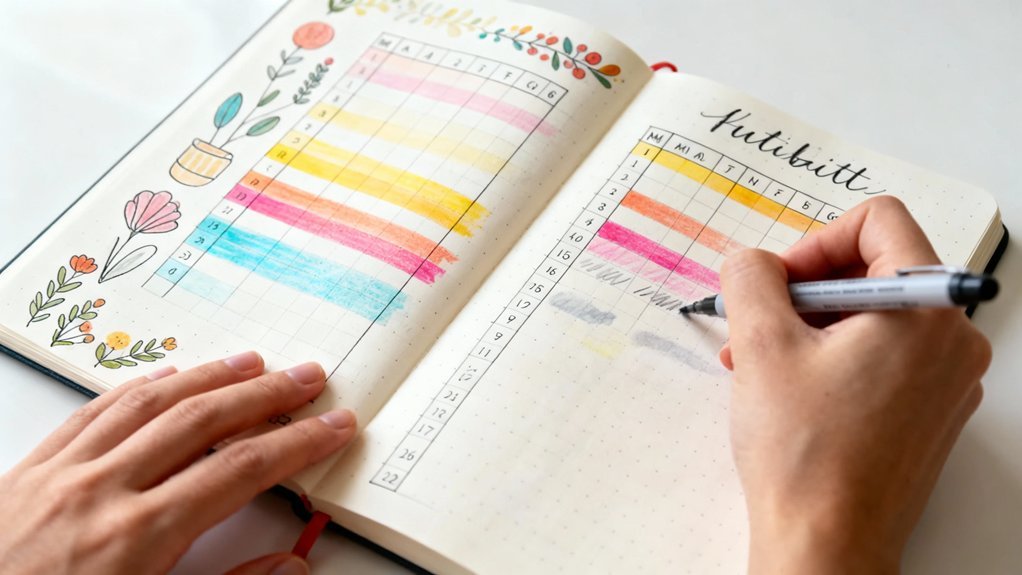
When you spot a small error in your bullet journal, resist the urge to tear out the page or start over. Instead, embrace error concealment techniques that'll convert mistakes into creative opportunities.
Don't let small mistakes derail your bullet journal—transform errors into creative features instead of starting fresh.
Try these bullet journal hacks:
- Use white correction tape for clean coverage, then write or draw over it.
- Apply decorative washi tape to mask errors while adding visual interest.
- Change misspellings into doodles—turn an unwanted letter into a small illustration or flourish.
For ink bleed-through, place strategic stickers or stamps on the reverse side.
You can also incorporate minimal geometric shapes to frame and disguise mistakes, making them look intentional. If you need additional journaling accessories like decorative tape or stickers to help with these fixes, having a variety of supplies on hand can make covering mistakes even easier.
Creative Ways to Transform Errors Into Decorative Elements
Sometimes the best fix isn't hiding your mistake—it's making it the star of the page. You can alter errors into intentional design elements using washi tape borders, turning wayward pen marks into quirky doodles, or strategically placing stickers that complement your spread.
This approach shifts your mindset from “I messed up” to “I created an unexpected feature,” turning imperfections into personalized touches that make your journal uniquely yours. The Bullet Journal Method embraces this flexibility because it adapts to your current circumstances rather than demanding perfection, helping you clear mental clutter and focus on what truly matters in your spreads.
Cover With Decorative Washi Tape
Washi tape offers one of the most versatile solutions for covering bullet journal mistakes while adding visual interest to your pages.
You'll convert errors into intentional design features through strategic placement and decorative layering.
Three effective washi tape techniques:
- Create borders and frames – Position strips around mistakes to establish defined sections that look purposefully designed rather than corrective.
- Layer complementary patterns – Combine multiple washi tape patterns at varying widths to build depth and visual complexity that completely conceals errors.
- Design geometric shapes – Cut tape into triangles, circles, or abstract forms to craft artistic elements that redirect attention from the original mistake.
This approach doesn't just hide errors—it elevates your journal's aesthetic.
You're not covering up; you're innovating unexpected opportunities for creative expression.
Turn Mistakes Into Doodles
Your pen slips, letters collide, or ink bleeds—but these imperfections become your canvas for spontaneous art. Alter errors into intentional designs using these doodle inspiration techniques that'll make mistakes vanish completely.
| Mistake Type | Doodle Solution |
|---|---|
| Stray ink dot | Convert to ladybug, flower center, or planet |
| Smudged line | Extend into branch, vine, or banner ribbon |
| Wrong letter | Add decorative swirls making it an ornamental capital |
| Bleed-through | Create watercolor effect background or shadow element |
| Crossed-out text | Alter into decorative strikethrough with leaves/stars |
Keep creative prompts handy—small botanical sketches, geometric patterns, or whimsical creatures work perfectly. You're not covering mistakes; you're evolving your spread organically. This approach trains your brain to see opportunities where you'd previously seen failures, ultimately improving your journaling confidence.
Add Stickers or Stamps
Stickers and stamps offer instant coverage for mistakes while adding personality to your spreads. Strategic sticker layering changes errors into intentional design elements that improve your pages rather than simply hiding problems.
Three techniques for effective coverage:
- Position decorative stamps over smudged ink or misspelled words, creating focal points that draw attention away from the original error.
- Layer complementary stickers of varying sizes to conceal larger mistakes while building visual depth and dimension.
- Use washi tape strips beneath stickers to create borders that naturally incorporate your corrections into the overall layout.
Smart stamp placement turns accidents into opportunities for experimentation.
You'll discover that “fixing” mistakes often produces more interesting results than your original plan, encouraging a more creative approach to journaling.
Correction Tools Every Bullet Journalist Should Have
Having the right correction tools in your bullet journal kit changes mistakes from frustrations into quick fixes.
You'll want white gel pens for covering small errors and adding highlights, washi tape for blocking larger mistakes while adding decorative flair, and correction tape for clean, paint-over-ready surfaces.
These three essentials give you flexible options that match any situation, whether you're rushing through a daily log or perfecting a monthly spread.
White Gel Pens
A white gel pen ranks among the most versatile correction tools you'll add to your bullet journal kit. These groundbreaking instruments change mistakes into opportunities for creative problem-solving.
Master these white gel pen techniques to enhance your journaling:
- Cover dark ink errors by applying multiple thin layers rather than one thick coat, allowing each layer to dry completely.
- Create decorative elements that camouflage mistakes by drawing borders, flourishes, or patterns that integrate the error into your design.
- Add highlights and accents to finished spreads, making corrections blend effortlessly with intentional embellishments.
Top white gel pen brands include Uni-ball Signo, Sakura Gelly Roll, and Muji. Test opacity on your paper type before committing to corrections.
You'll discover that imperfections become launching points for unexpected creativity.
Washi Tape Solutions
When you need to conceal larger errors or reimagine entire sections, washi tape delivers instant modification without permanent commitment. Layer decorative strips over mistakes to convert failures into intentional design elements.
You'll discover that strategic placement changes problematic spreads into improved layouts. Choose washi tape patterns that complement your existing color schemes while masking unwanted content beneath.
Semi-transparent varieties allow subtle coverage, while opaque options provide complete concealment. Create washi tape borders around corrected sections to establish cohesive visual boundaries that distract from underlying errors.
Stack multiple strips to build dimension and interest where mistakes once dominated. You're not just covering problems—you’re generating opportunities for experimental layouts.
This approach lets you iterate freely, knowing any misstep becomes raw material for your next creative evolution.
Correction Tape Options
While washi tape excels at altering visible mistakes into design features, sometimes you need errors to disappear completely. Correction tools offer precision solutions when you're reimagining your spreads.
Essential correction options include:
- Liquid correction fluid – Apply thin layers over ink mistakes, letting each dry completely before rewriting. Modern formulas dry fast and accept pen ink without bleeding.
- Correction tape dispensers – These deliver instant, no-wait coverage that's perfect for quick fixes. You'll write immediately over the applied strip without smudging concerns.
- Precision correction pens – Target small errors with pinpoint accuracy, ideal for correcting individual letters or numbers within tight spaces.
You're not hiding imperfections—you're creating room for better iterations. These tools convert mistakes into opportunities for refined execution.
Dealing With Ink Smudges and Bleeding
Ink smudges and bleeding can derail your bullet journal's clean aesthetic, but they're fixable with the right approach. Deploy blotting paper immediately when mishaps occur—it'll absorb excess ink before it spreads further. For stubborn smudges, try layering gesso or white gel pen over the affected area, then redraw your design.
Prevention beats correction every time. Master these ink absorption techniques: test new pens on your journal's last page first, and keep a scrap paper beneath your writing hand.
Consider switching to quick-dry inks or fine-tip pens that minimize bleeding through thin pages.
When bleeding does occur, convert it into a feature rather than fighting it. Add decorative borders around problem areas, incorporate washi tape overlays, or extend the design to encompass the bleed.
These smudge prevention tips will keep your spreads pristine, but remember—adaptability matters more than perfection in your creative practice.
When to Embrace Imperfection Instead of Fixing
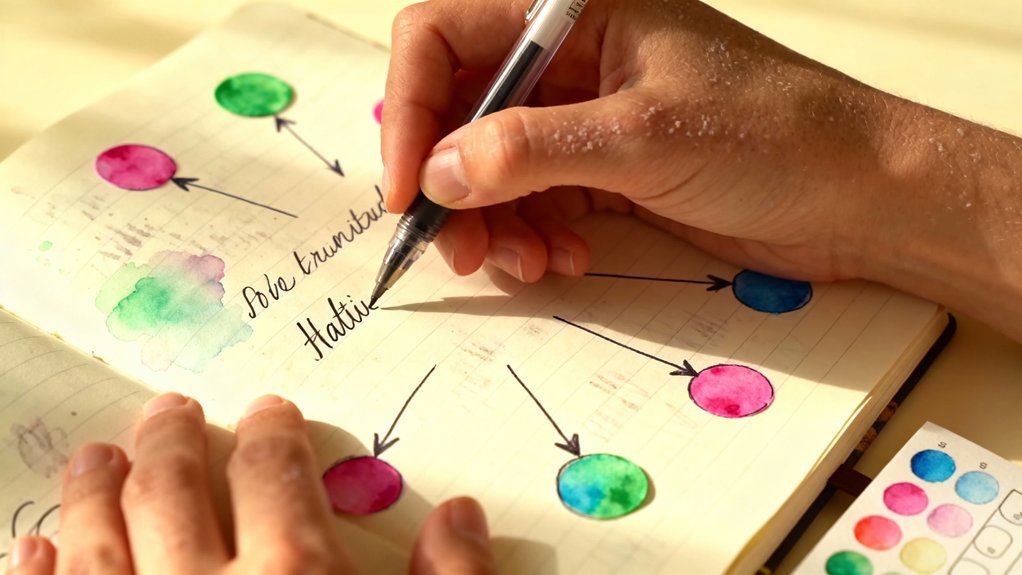
Sometimes the best fix is no fix at all—your bullet journal becomes more authentic when you let certain mistakes stand. Embracing flaws alters your journal from a perfectionist's prison into a genuine reflection of your journey.
Perfectionism imprisons your bullet journal—authenticity liberates it through embraced flaws and honest imperfections.
Consider when imperfection serves you better:
- Minor date errors or misspellings that don't affect functionality become personality markers, celebrating uniqueness in your spreads rather than demanding correction time you'd rather spend planning.
- Wonky hand-drawn decorations that add character—your asymmetrical banner or slightly crooked line proves you're human, not a machine churning out identical layouts.
- Experimental designs that didn't work teach valuable lessons about what resonates with your workflow, making them worth preserving as reference points.
Your bullet journal isn't a museum piece; it's a working tool. When you stop obsessing over every imperfection, you'll actually use it more consistently.
That smudge or crooked header? It's proof you're innovating, adapting, and moving forward.
Salvaging Entire Pages That Didn't Go as Planned
When an entire page becomes a disaster—ink bleeds through, the layout collapses, or you realize halfway through it won't work—you've got three salvage strategies that'll rescue your effort.
First, alter it using page overlays. Attach decorative paper, washi tape grids, or adhesive pockets directly over the problematic areas. This creates functional layers while concealing mistakes beneath.
Second, convert disasters into creative collages. Cut magazine images, print digital designs, or use scrapbook elements to build entirely new compositions over failed layouts. The original mistake becomes your foundation rather than your limitation.
Third, repurpose the page completely. That botched weekly spread? Turn it into a brainstorming zone, testing ground for future layouts, or a mixed-media art page.
Function follows form when you're willing to pivot. These approaches don't just fix problems—they generate unexpected solutions you wouldn't have discovered through perfect execution. Your failed page becomes an innovation catalyst.
Frequently Asked Questions
How Do I Prevent Mistakes in My Bullet Journal Before They Happen?
You'll prevent most mistakes by implementing smart planning strategies before you commit pen to paper.
Sketch layouts lightly in pencil first, or test designs on scrap paper. Practice mindful journaling by slowing down and double-checking dates, headers, and spacing.
Don't let perfectionism paralyze you—embrace a flexible mindset where “mistakes” become creative opportunities. Use rulers for straight lines, count boxes before drawing grids, and remember that your journal's meant to serve you, not constrain you.
Can I Remove Pages From My Bullet Journal Without Damaging the Binding?
You can absolutely remove pages if you're strategic about it.
Use page removal techniques that match your journal's binding—carefully cut pages close to the spine with a craft knife for glued bindings, or work stitches loose with a seam ripper for sewn ones.
Most binding techniques allow some flexibility without falling apart.
Just don't remove too many consecutive pages, or you'll weaken the structure.
Consider it creative problem-solving, not destruction.
Should I Restart My Entire Bullet Journal if I Make Multiple Mistakes?
Don't throw the baby out with the bathwater—you shouldn't restart your entire bullet journal over mistakes. Instead, embrace imperfections as part of your creative journey.
Use washi tape, correction tape, or decorative stickers to cover errors. Alter mistakes into design features by adding illustrations or doodles around them.
Starting over wastes your previous work and momentum. Your bullet journal's meant to evolve with you, so adapt rather than abandon it when things don't go perfectly.
What Paper Quality Works Best for Minimizing Mistakes in Bullet Journals?
You'll want paper thickness of at least 100gsm to prevent ink bleed and reduce show-through that makes mistakes more visible.
Thicker paper lets you correct errors with washi tape or white-out without compromising the page's integrity. Look for acid-free options that won't yellow over time.
However, don't let paper quality paralyze you—even premium notebooks can't prevent all mistakes, so embrace imperfection as part of your creative journey.
How Do Professional Bullet Journalists Handle Mistakes in Their Published Spreads?
Professional bullet journalists embrace imperfection rather than hide it.
They'll strategically employ mistake correction techniques like decorative washi tape, strategic stickers, or intentional doodles that convert errors into design features.
You'll notice creative cover ups aren't about perfection—they're about adaptation.
They'll incorporate mistakes into borders, turn smudges into shadows, or add embellishments that make errors disappear.
This flexible approach demonstrates that innovation thrives when you view mistakes as unexpected opportunities rather than failures.
Conclusion
You'll make mistakes in about 60% of your spreads—studies show most bullet journalists abandon their first three notebooks before finding their rhythm. Instead of viewing errors as failures, you've now got practical fixes at your fingertips. Whether you're covering up, altering, or embracing those imperfections, remember: your journal's meant to serve you, not intimidate you. Adapt these solutions to fit your style, and keep moving forward without the pressure of perfection.



